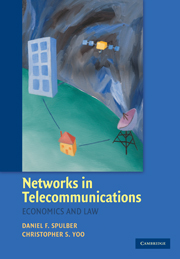Book contents
- Frontmatter
- Contents
- Preface
- Acknowledgments
- Introduction
- PART I THE ECONOMICS OF NETWORKS
- PART II THE REGULATION OF NETWORKS
- 4 Network Regulation Basics
- 5 Economic Effects of Regulating Access to Networks
- 6 Pricing of Access to Networks
- 7 Constitutional Limits on the Pricing of Access to Networks
- PART III POLICY APPLICATIONS
- Conclusion
- Bibliography
- Index
- Table of Cases
5 - Economic Effects of Regulating Access to Networks
Published online by Cambridge University Press: 05 June 2012
- Frontmatter
- Contents
- Preface
- Acknowledgments
- Introduction
- PART I THE ECONOMICS OF NETWORKS
- PART II THE REGULATION OF NETWORKS
- 4 Network Regulation Basics
- 5 Economic Effects of Regulating Access to Networks
- 6 Pricing of Access to Networks
- 7 Constitutional Limits on the Pricing of Access to Networks
- PART III POLICY APPLICATIONS
- Conclusion
- Bibliography
- Index
- Table of Cases
Summary
On the afternoon of August 14, 2003, a major power blackout struck the northeastern and midwestern United States and parts of Ontario, Canada. The power outage cascaded across cities and states, forcing businesses to close, cutting power to households, and shutting down communications networks, affecting over 50 million people. The outage stranded commuters with traffic jams, closed bridges and tunnels, and stalled public transportation systems. The problem began in Ohio when three high-voltage transmission lines of First Energy Corporation made contact with trees. Because of malfunctioning control-room equipment at First Energy, the utility failed to detect the problem and to warn other utilities. The downed lines caused power to overload the grid, which in turn led to further breakdowns in the transmission network. The Midwest Independent System Operator and the reliability control area for Pennsylvania, New Jersey, and Maryland (the PJM Interconnection) lacked the information and procedures to address the transmission problems.
The dramatic story of the Northeast power outage illustrates the complexities of networks – both in balancing the supply and demand for network capacity and in coordinating the interconnection of networks. Monitoring the performance of a single network is hard enough, and the transaction costs of coordinating network interactions are even higher.
Although communications networks face different types of problems than electric power networks, they also involve highly complex problems of network management and interconnection. Regulatory efforts to mandate access to communications networks can substantially increase this complexity.
- Type
- Chapter
- Information
- Networks in TelecommunicationsEconomics and Law, pp. 152 - 189Publisher: Cambridge University PressPrint publication year: 2009



